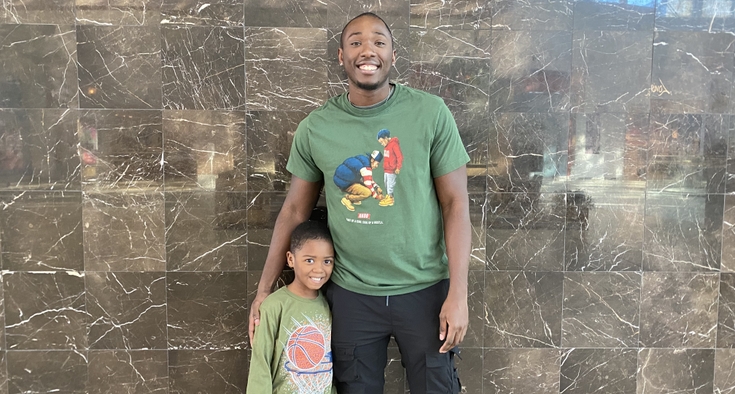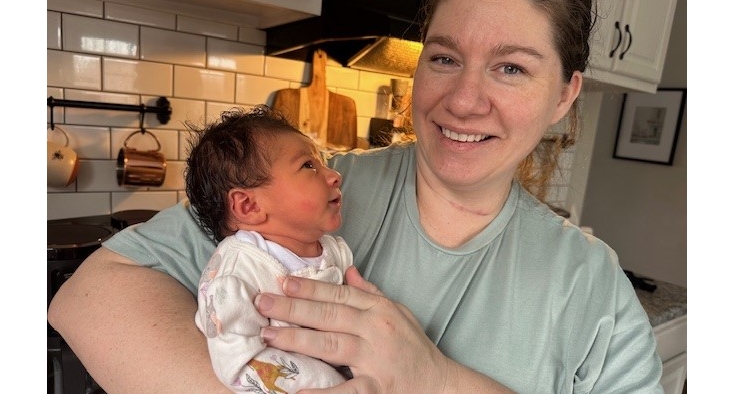Zac Hullander has spent a lot of time at Novant Health Presbyterian Medical Center’s Hemby Children’s Hospital.
He and his mom, Natalie Hullander, first came to Hemby when Zac, now 17 and a junior at South Point High School in Belmont, was just 4. They’ve gotten to know and love a lot of the team members, and the feeling is mutual.
During Zac’s most recent stay, he said he “was playing really good music in my hospital room after my brain surgery, and the nurses loved it.”
His mom added, “The nurses called Zac’s room the ‘party room.’”
But it was more than a party. When the nurses told Zac he’d make a good DJ, he took it to heart. That’s now his career ambition, and he’s already taking lessons so he’ll be ready when he graduates in 2026.
Complete neurological care for your child.
From ear infections to leukemia to epilepsy
More than 10 years ago, chronic ear infections led Hullander to bring her little boy to Hemby for the first time. Zac’s bloodwork led doctors to discover – unrelated to his ear infections – an elevated white blood cell count. He had leukemia. Chemotherapy ultimately cured Zac’s leukemia, but its toxicity led to other issues. Major ones. Zac had seizures and a stroke.
Those are rare side effects and “an unfortunate cost of the cure,” said Dr. Erin Kiehna, of Novant Health Pediatric Neurosurgery – Cotswold, Zac’s pediatric neurosurgeon.
Zac’s first seizure occurred in April 2011 – the first time he was given chemo. He was diagnosed with posterior reversible encephalopathy syndrome. That landed him in the pediatric intensive care unit (PICU) for three months. When he was released that June, he had regressed to the point his mom felt like she was taking an infant home with her rather than her 4-year-old.
“He couldn’t walk or crawl,” she said. “I had to lay him on a blanket on the floor like I did when he was an infant.”
That summer, Zac regained what he lost, including his ability to walk. But in September 2011, Zac had a stroke.
In 2014, Zac was diagnosed with drug-resistant epilepsy. Around 70% of patients with epilepsy can effectively manage their seizures with a single anti-seizure medication. For those who don’t respond to the first drug, about 30% might see improvement with a second medication, and only 5% to 15% may respond to a third drug regimen. Zac’s epilepsy team tried seven anti-seizure medications – but none resulted in seizure freedom.
Best doctors. Amazing nurses. Remarkable care.
With Zac still averaging two or three seizures a week, the epilepsy team met to discuss Zac’s remaining options, which included surgery. After reviewing all the options with the family, they chose to pursue a vagal nerve stimulator (VNS), a less invasive way to help control seizures.
When Zac was 10, Kiehna implanted a VNS. The VNS was a “game changer for Zac,” said Hullander, “because it shortened his seizures to about a half a minute.” Still, the seizures persisted.
Kiehna and Zac discussed it and agreed Zac didn’t have the quality of life they’d hoped for. “While a resective surgery (one that removes a specific part of an organ or tissue) would be much more invasive, Zac was a good candidate for further work-up,” said Kiehna.
Zac was on board with the idea. “He was willing to take that big step if it meant he could be seizure-free or close to it,” Hullander said.
Worth the risk?
Zac and his mom were hopeful, but a little skeptical. “We had hoped, after he got off chemo, that he’d stop having seizures,” Hullander said. “When that didn't happen, I thought he’d always have them. They just became a regular occurrence – something we had to deal with.”
Testing showed that Zac’s seizures were localized to one side of the brain – the area injured in the stroke. But it wasn’t clear how extensive the network was that was causing his seizures. He needed one surgery just to determine if he was a good candidate for resective brain surgery.
His mom was nervous.
“I was scared he’d lose memory, function – that he wouldn’t be the same Zac,” said Hullander. “But Dr. Kiehna said Zac would feel better without that damaged tissue in his brain. I have a lot of confidence and trust in her. She knows what she’s doing.”
It’s a fear Kiehna has heard before. “Patients and their parents worry about a personality change as a result of brain surgery,” she said. “Surgeons always have to weigh the risks and benefits and help guide our patients to the best decision for them. We don’t like to do brain surgery unless we believe the patient will be at least 60% to 80% seizure-free as a result.”
Given the brain’s neuroplasticity – and Zac’s youth – Kiehna felt the potential benefits of his carefully planned surgery outweighed the risks. “Zac is young,” she said. “His brain would still have an opportunity to fine-tune the connections.”
Hullander was reassured. “It was nice to have already been through one surgery with Dr. Kiehna before the brain surgery,” she said.
‘Just normal Zac’
This time, Zac was at Hemby for 17 days. He checked in last July 24 for the first surgery. He was then weaned off his seizure medicine, and everyone waited to capture seizure recordings. In Zac’s case, it took 10 days to get the data the epilepsy team needed to pinpoint where the seizures were coming from.
Kiehna performed a partial right frontal lobectomy on August 5, 2024. It’s a major surgery that can take up to six hours. Kiehna had to be careful to “only disconnect the parts of the brain causing the seizures” and to “avoid parts of the brain involved in speech and language.”

Those six hours felt like six weeks to Hullander, but relief came quickly. “Pretty much right after he woke up from surgery, I knew he was just normal Zac,” she said. “Brain surgery sounds like a big, scary thing, but it wasn’t. It was truly a blessing.”
The day after surgery, Hullander discovered her car-obsessed teen “surfing online for cars because – like all 17-year-old boys – he wants to drive.”
Zac has his eye on a Corvette.
Prior to Zac’s surgery, driving hadn’t been an option. “But we’re hopeful that a driver’s license may be in his future,” Hullander said.
Zac returned home four days after surgery. He complained of headaches those first couple of days, but they cleared up within a week.
As of late March, Zac has been seizure-free for more than seven months. He’ll remain on his anti-seizure medications for at least six months post-surgery. He’s already being weaned off one.
“It’s been a relief for me,” said Hullander. “After all our challenges, it finally feels like there’s a light at the end of the tunnel. Zac used to get the sensation he needed to go to the bathroom whenever a seizure was coming on. When he’d get up in the middle of the night, I'd wake up and wonder: Is he going to have a seizure? That doesn’t happen now. I didn’t realize until after the surgery how stressed I was all the time.”
Soon after Zac was released from the hospital, Hullander took him bowling and to hit golf balls – two sports he loves. And ones he can now enjoy without fear he’ll have a seizure while playing.
Ask Zac how he’s feeling now, and his one-word answer conveys more than any lengthy treatise ever could.
His response? “Powerful.”











